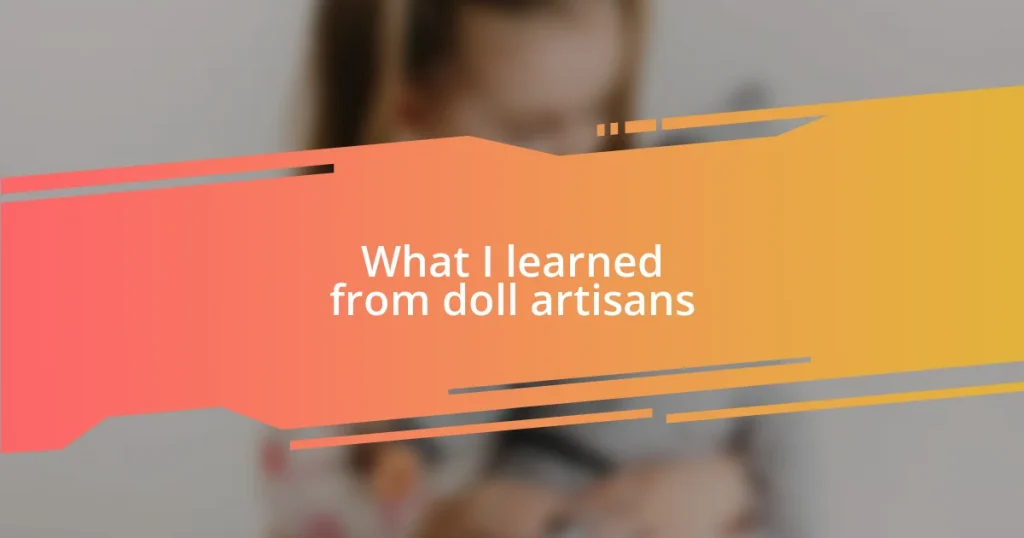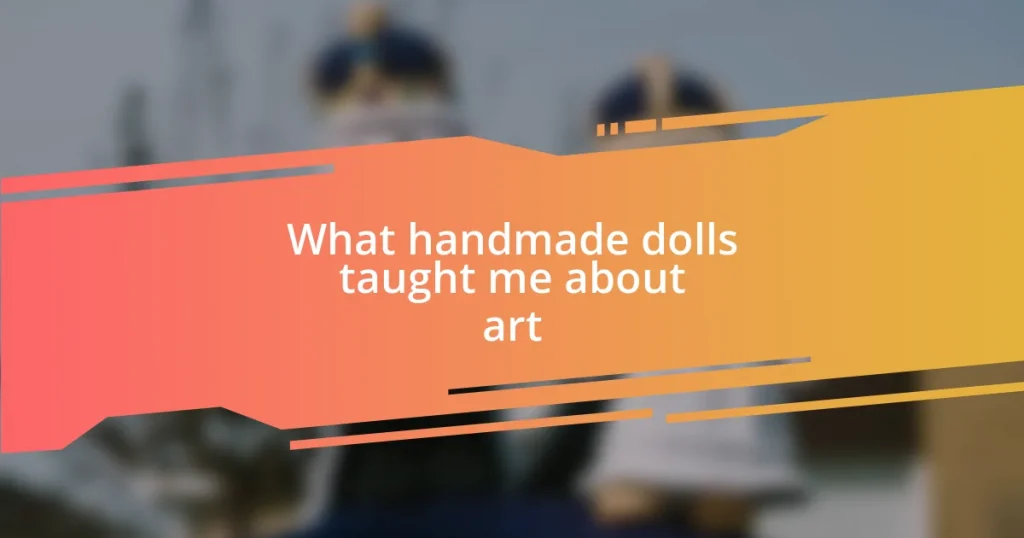Key takeaways:
- Doll artisans invest significant emotion and dedication into their craft, with each doll reflecting their unique story and perspective.
- The history of doll making showcases its evolution from simple toys in ancient cultures to intricate, customizable pieces that convey social values and personal narratives.
- Aspiring doll makers are encouraged to start small, explore various techniques, and document their progress to foster growth and creativity in their craft.

Introduction to Doll Artisans
Doll artisans are truly fascinating individuals who transform simple materials into intricate works of art. I remember the first time I held a handcrafted doll; it felt like I was connecting with the artisan’s soul. Have you ever wondered what goes through an artisan’s mind as they create their pieces?
Many people don’t realize the dedication and skill that goes into doll-making. I once visited a local workshop and was mesmerized by how the artisans poured their emotions into every stitch and brushstroke. Each doll tells a story, reflecting the artisan’s unique perspective and craftsmanship.
The world of doll artisans is a vibrant community that celebrates creativity, tradition, and innovation. I enjoy hearing their stories—like the artisan who uses sustainable materials to tell tales of environmental consciousness through dolls. How can something so small encapsulate such immense passion and thought? It’s a reminder that art has the power to evoke emotions and provoke thoughts beyond its physical form.

The History of Doll Making
Doll making has a rich history that spans thousands of years. I find it fascinating how it began with early cultures creating dolls from natural materials like clay, wood, and cloth, intended primarily as toys for children. This practice not only served as a form of play but also carried significant cultural symbols, illustrating the values and traditions of a community.
As the centuries progressed, I see how doll making evolved alongside society itself. In the 19th century, for example, Elizabethan fashion dolls emerged, showcasing exquisite attire that reflected the era’s social status and wealth. This artistry resonated with me during a visit to a historical museum where I marveled at the intricate details—the delicate lacework and vibrant fabrics truly brought history to life.
Today, doll making is a blend of tradition and modern inspiration. I often ponder how customized dolls, like those made from recycled materials or reflecting diverse backgrounds, exemplify society’s shift towards acceptance and environmental awareness. Isn’t it incredible how a simple doll can carry so much meaning and message?
| Era | Key Characteristics |
|---|---|
| Ancient Civilizations | Made from natural materials; often symbolic in nature. |
| 19th Century | Fashion dolls representing social status; elaborate designs. |
| Modern Day | Focus on customization and representation; use of diverse materials. |

Techniques Used by Doll Artisans
Artisans utilize a variety of techniques to bring their doll creations to life, each method reflecting their unique style and emotional connection to the craft. I recall visiting an artisan who meticulously hand-paints each doll’s features, pouring not just skill, but heart into every brushstroke. It struck me how much thought goes into color choices and expressions, as they can evoke a whole range of emotions in the viewer.
Some prominent techniques include:
- Sculpting: Crafting the doll’s body and facial features from materials like clay or resin.
- Sewing: Creating intricate clothing pieces that embody each artisan’s design vision.
- Painting: Hand-painting the doll’s face and limbs to bring out personality and character.
- Assembly: Piecing together various components, ensuring each part aligns perfectly in both aesthetic and function.
- Finishing Touches: Adding accessories like wigs or jewelry to enhance the doll’s individuality.
I find it fascinating how each technique not only showcases skill but also the stories woven into every doll. Just the other day, I watched someone craft a doll from vintage fabrics, and I could feel the nostalgia pour out with each stitch—a true testament to how the past influences the present in craft.

Materials for Doll Crafting
When it comes to materials for doll crafting, the choices seem endless, each one bringing a unique quality to the final product. I’ve often walked through artisan workshops, surrounded by fabrics, woods, and clays, which reminds me just how important the right materials can be. For instance, working with natural fabrics not only gives a soft touch but also offers a tactile connection to the doll, making it feel more alive. Have you ever touched a hand-sewn doll? The warmth of the fabric is unbeatable.
I remember a particular day spent with a local doll maker who specialized in using recycled materials. It was inspiring to see how she transformed discarded items into beautiful, one-of-a-kind pieces. Each doll had a story—an old sweater became a cozy outfit, and buttons turned into charming accessories. This kind of creativity underscores an important lesson: materials tell their own tales, resonating with memories and emotions that transcend their original purpose.
Plastic and resin have gained popularity for their durability and versatility. While some might view these materials as cold or impersonal, I believe they open up a world of possibilities. A resin doll can be dyed in vibrant colors and molded into intricate shapes, offering artists more freedom in their designs. Yet, I can’t help but ask, what’s more important: the material you use or the love you put into crafting? In my experience, it’s the passion behind the work that truly brings a doll to life, regardless of the materials chosen.

Insights from Experienced Artisans
I’ve had the privilege of chatting with experienced artisans who emphasize the importance of storytelling in their work. One artisan I met spoke passionately about how each doll should convey a narrative, sometimes using an unusual combination of materials to evoke a specific scene or emotion. I remember her saying, “Every character wants to be remembered; it’s my job to ensure they tell their story.” It got me thinking—how often do we overlook the power of storytelling in our own creative pursuits?
Another intriguing insight I gathered is the role of patience in doll-making. During a workshop, I observed a skilled artisan who spent hours perfecting the tiniest details on a doll’s face. When I asked her about her process, she smiled and said, “Rushing leads to regrets; each layer deserves time to breathe.” This patience not only enhances the final product but also reflects her respect for the craft. Have you ever felt that sense of fulfillment after focusing intensely on a task? It’s a singular feeling that transforms not just the piece you’re creating, but also your perspective on the craft.
Interestingly, many artisans mentioned the community aspect of doll-making. They often collaborate, sharing techniques and inspirations, which enriches their artistry. We were learning a new sewing technique together, and one artisan confessed that every doll created in tandem represents a bond—something far greater than the sum of their parts. I pondered, what if we approached all our creative endeavors that way? Wouldn’t it deepen our appreciation for the interconnectedness of art and relationships?

Tips for Aspiring Doll Makers
I’ve found that starting small is crucial for aspiring doll makers. When I decided to create my first doll, I focused on a simple design. This approach allowed me to hone my skills without feeling overwhelmed. Remember, every expert was once a beginner, so don’t be afraid to make mistakes—each one is a step toward growth.
Exploring various techniques can be incredibly rewarding. During my journey, I experimented with knitting, sewing, and even sculpting. While some projects didn’t turn out as I envisioned, those experiences taught me a lot about materials and how they interact. Have you ever tried a technique that surprised you? I definitely have! It was fascinating to discover how a simple twist in method could completely transform my doll.
One of the best tips I received was to document my progress. I took photos of each stage, capturing not just the final piece but also the learning moments. Reflecting on these snapshots made me appreciate my journey, both the successes and the setbacks. How do you keep track of your creative evolution? For me, looking back at those snapshots sparked motivation and reminded me of the joy in the process, reinforcing that every stitch counts in the grand tapestry of creativity.












